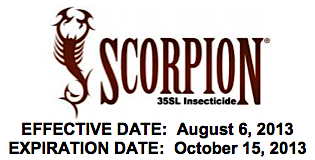Crawler counts have increased again since last week. Growers who had infested berries during the first generation should treat this generation as soon as possible. Esteem and Diazinon are the suggested products.
Life History
Scales feed on plant sap, decreasing plant vigor and fruit yield. Adult scales are protected from insecticide sprays by a waxy covering. These insects are common in older canes when not removed, and located mostly under loose bark. In New Jersey, the Putnam scale has two generations a year. It overwinters as second-instar nymphs under loose bark. Spring activity begins in early February. Eggs from the first generation are laid in late April, and immature “crawlers” begin to appear in mid-May. Peak crawler emergences occur in late May and early June. Peak crawler emergences for the second generation occur in early to mid-August (this time of the year).
Monitoring and Management
Growers that have a scale problem need to treat post harvest for the 2nd generation of crawlers (use Diazinon or Esteem). Crawlers can be monitored by wrapping black electricians’ tape covered by double-sided sticky tape around canes. Use a hand lens to see crawlers on the sticky tape. Sprays should coincide with crawler emergence.

